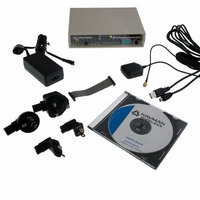AA003257-G Navman Wireless, AA003257-G Datasheet - Page 14

AA003257-G
Manufacturer Part Number
AA003257-G
Description
DEV KIT FOR JUPITER 32XLP
Manufacturer
Navman Wireless
Type
Receiver, GPSr
Specifications of AA003257-G
Frequency
1575.42MHz
For Use With/related Products
Jupiter 32 XLP
Lead Free Status / RoHS Status
Lead free / RoHS Compliant
Other names
943-1001
Available stocks
Company
Part Number
Manufacturer
Quantity
Price
Company:
Part Number:
AA003257-G
Manufacturer:
Navman Wireless
Quantity:
135
6.0 Software interface
The host serial I/O port of the receiver’s serial data interface supports full duplex communication
between the receiver and the user.
The default serial modes are as follows:
6.1 NMEA output messages
NMEA is a standard protocol used by GPS receivers to transmit data. Output NMEA (0183 v2.2)
messages for the Jupiter 32 xLP are listed in Table 6-1. A complete description of each NMEA
message is contained in the Navman NMEA reference manual (Part Number MN000315).
6.2 SiRF Binary
SiRF Binary is the proprietary interface protocol of SiRF. It allows the Jupiter 32 a greater level
of configurability and a more standardised message set than NMEA. A complete description of
each binary message is contained in the SiRF Binary Protocol reference manual.
6.3 Software functions and capabilities
Table 6-2 shows the software features available to the Jupiter 32 xLP.
LA000267D © 2008 Navman Wireless OEM. All rights reserved. Proprietary information and specifications subject to change without notice.
SBAS capability
Adaptive
TricklePower
Push-to-Fix
Ephemeris Push
Almanac to Flash
Low signal
acquisition
Low signal
navigation
1 PPS
Write Configurations
to Flash
Pre-defined Profiles
yes
•
•
Port A: NMEA, 9600 bps, 8 data bits, no parity, 1 stop bit
Port B: SiRF Binary, 38 400 bps, 8 data bits, no parity, 1 stop bit
= always enabled
Feature
GGA – global positioning system fix data
GSA – DOP and active satellites
GSV – satellites in view
RMC – recommended minimum specific GPS data
VTG – track made good and ground speed
GLL – latitude, longitude, UTC of position fix and status
ZDA – PPS timing message
A = available, but not enabled by default
Improves position accuracy by using freely available satellite-
based correction services called SBAS (Satellite Based
Augmentation System)
Improves battery life by using enhanced power management and
intelligently switching between low and full power depending on
the current GPS signal level. Refer to the Low Power Operating
Modes application note.
Provides an on-demand position fix mode designed to further
improve battery life. Refer to the Low Power Operating Modes
application note.
allows hot start performance at all times including in weak
conditions and moving start ups
Improves cold start times by storing the most recent almanac to
flash memory.
Acquires satellites and continues tracking in extremely low signal
environments.
Continues navigating in extremely low signal environments.
A timing signal generated every second on the second.
Saves and restores user configurations and preferences to Flash
memory. Refer to Saving and retrieving configuration data to
Flash application note.
Allows easy selection of predefined user/application profiles.
Refer to Jupiter 32 Integrator’s Guide.
Message ID and description
Table 6-2: Jupiter 32 xLP software capability
Table 6-1: Default NMEA messages
Description
Refresh rate
1 s
1 s
1 s
1 s
1 s
1 s
1 s
Availability
yes
yes
yes
yes
yes
yes
yes
A
A
A
1






















